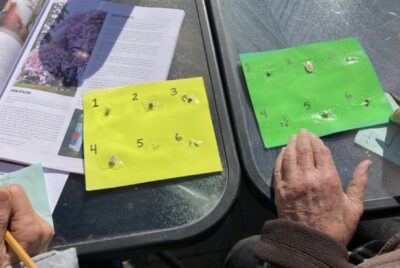RESEARCH
Comparative Efficacy of Various Art Therapies for Patients with Dementia: A Network Meta-Analysis of Randomized Controlled Trials
Summary
This study looked at different types of art therapies to see which ones work best for people with dementia. Dementia is a serious health problem that affects memory and thinking skills. Art therapies, like music, painting, or gardening, are often used to help people with dementia. The researchers combined the results of 39 studies with nearly 3,000 participants to compare the effects of different art therapies on things like memory, daily living skills, mood, anxiety, agitation, and quality of life. They found that calligraphy (artistic handwriting) might be the best for improving memory and quality of life, while horticultural therapy (gardening) might be the best for reducing agitation.
The study suggests that art therapies can be helpful for people with dementia, but some might be better than others depending on the specific symptoms. Calligraphy could improve memory and overall well-being, while gardening could reduce agitation. The researchers recommend that healthcare professionals consider using these art therapies to help people with dementia. However, more research is needed to confirm these findings and figure out exactly how these therapies work.
Link
Notes/Suggestions
1.Tiwari S, Atluri V, Kaushik A, Yndart A, Nair M. Alzheimer’s disease: pathogenesis, diagnostics, and therapeutics. Int J Nanomed. (2019) 14:5541–54. 10.2147/IJN.S200490 [DOI] [PMC free article] [PubMed] [Google Scholar]
2.Sengoku R. Aging and Alzheimer’s disease pathology. Neuropathology. (2020) 40:22–9. 10.1111/neup.12626 [DOI] [PubMed] [Google Scholar]
3.Grande G, Qiu C, Fratiglioni L. Prevention of dementia in an ageing world: evidence and biological rationale. Ageing Res Rev. (2020) 64:101045. 10.1016/j.arr.2020.101045 [DOI] [PubMed] [Google Scholar]
4.Livingston G, Huntley J, Sommerlad A, Ames D, Ballard C, Banerjee S, et al. Dementia prevention, intervention, and care: 2020 report of the lancet commission. Lancet. (2020) 396:413–46. 10.1016/S0140-673630367-6 [DOI] [PMC free article] [PubMed] [Google Scholar]
5.Sakamoto M, Ando H, Tsutou A. Comparing the effects of different individualized music interventions for elderly individuals with severe dementia. Int Psychogeriatr. (2013) 25:775–84. 10.1017/S1041610212002256 [DOI] [PMC free article] [PubMed] [Google Scholar]
6.Jia J, Wei C, Chen S, Li F, Tang Y, Qin W, et al. The cost of Alzheimer’s disease in China and re-estimation of costs worldwide. Alzheimers Dement. (2018) 14:483–91. 10.1016/j.jalz.2017.12.006 [DOI] [PubMed] [Google Scholar]
7.Lochhead J, Nelson M, Maguire G. The treatment of behavioral disturbances and psychosis associated with dementia. Psychiatr Pol. (2016) 50:311–22. 10.12740/PP/60904 [DOI] [PubMed] [Google Scholar]
8.Gbd 2016 Dementia Collaborators. Global, regional, and national burden of Alzheimer’s disease and other dementias, 1990-2016: a systematic analysis for the global burden of disease study 2016. Lancet Neurol. (2019) 18:88–106. 10.1016/S1474-442230403-4 [DOI] [PMC free article] [PubMed] [Google Scholar]
9.Gauthier S, Albert M, Fox N, Goedert M, Kivipelto M, Mestre-Ferrandiz J, et al. Why has therapy development for dementia failed in the last two decades? Alzheimers Dement. (2016) 12:60–4. 10.1016/j.jalz.2015.12.003 [DOI] [PubMed] [Google Scholar]
10.Calsolaro V, Antognoli R, Okoye C, Monzani F. The use of antipsychotic drugs for treating behavioral symptoms in Alzheimer’s disease. Front Pharmacol. (2019) 10:1465. 10.3389/fphar.2019.01465 [DOI] [PMC free article] [PubMed] [Google Scholar]
11.Camic P, Zeilig H, Crutch S. The arts and dementia: emerging directions for theory, research and practice. Dementia. (2018) 17:641–4. 10.1177/1471301218772972 [DOI] [PubMed] [Google Scholar]
12.Lin R, Yan Y, Luo Y, Lin H. Research progress on the application of art therapy in the elderly with cognitive impairment. Chin Nurs Manage. (2021) 21:1240–4. 10.3969/j.issn.1672-1756.2021.08.024 [DOI] [Google Scholar]
13.Roe B. Arts for health initiatives: an emerging international agenda and evidence base for older populations. J Adv Nurs. (2014) 70:1–3. 10.1111/jan.12216 [DOI] [PubMed] [Google Scholar]
14.Shamseer L, Moher D, Clarke M, Ghersi D, Liberati A, Petticrew M, et al. Preferred reporting items for systematic review and meta-analysis protocols (PRISMA-P) 2015: elaboration and explanation. BMJ. (2015) 350:g7647. 10.1136/bmj.g7647 [DOI] [PubMed] [Google Scholar]
15.McKhann G, Knopman D, Chertkow H, Hyman B, Jack C, Jr., Kawas C, et al. The diagnosis of dementia due to Alzheimer’s disease: recommendations from the national institute on aging-Alzheimer’s association workgroups on diagnostic guidelines for Alzheimer’s disease. Alzheimers Dement. (2011) 7:263–9. 10.1016/j.jalz.2011.03.005 [DOI] [PMC free article] [PubMed] [Google Scholar]
16.Sterne J, Savović J, Page M, Elbers R, Blencowe N, Boutron I, et al. RoB 2: a revised tool for assessing risk of bias in randomised trials. BMJ. (2019) 366:l4898. 10.1136/bmj.l4898 [DOI] [PubMed] [Google Scholar]
17.Begg C, Mazumdar M. Operating characteristics of a rank correlation test for publication bias. Biometrics. (1994) 50:1088–101. [PubMed] [Google Scholar]
18.Higgins J, Thompson S. Quantifying heterogeneity in a meta-analysis. Stat Med. (2002) 21:1539–58. 10.1002/sim.1186 [DOI] [PubMed] [Google Scholar]
19.Puhan M, Schünemann H, Murad M, Li T, Brignardello-Petersen R, Singh J, et al. A GRADE working group approach for rating the quality of treatment effect estimates from network meta-analysis. BMJ. (2014) 349:g5630. 10.1136/bmj.g5630 [DOI] [PubMed] [Google Scholar]
20.Yuan L. Effect of arithmetic or drawing writing on communication and cognitive function in patients with mild to moderate dementia. Ph. D, Thesis. Guangzhou Medical University; (2018). [DOI] [PMC free article] [PubMed] [Google Scholar]
21.Chu K, Huang C, Ouyang W. Does Chinese calligraphy therapy reduce neuropsychiatric symptoms: a systematic review and meta-analysis. BMC Psychiatry. (2018) 18:62. 10.1186/s12888-018-1611-4 [DOI] [PMC free article] [PubMed] [Google Scholar]
22.Pérez-Sáez E, Justo-Henriques S, Alves Apóstolo J. Multicenter randomized controlled trial of the effects of individual reminiscence therapy on cognition, depression and quality of life: analysis of a sample of older adults with Alzheimer’s disease and vascular dementia. Clin Neuropsychol. (2021) 2021:1–22. 10.1080/13854046.2021.1871962 [DOI] [PubMed] [Google Scholar]
23.Kao H, Zhu L, Chao A, Chen H, Liu I, Zhang M. Calligraphy and meditation for stress reduction: an experimental comparison. Psychol Res Behav Manage. (2014) 7:47–52. 10.2147/PRBM.S55743 [DOI] [PMC free article] [PubMed] [Google Scholar]
24.Pedrinolla A, Tamburin S, Brasioli A, Sollima A, Fonte C, Muti E, et al. An indoor therapeutic garden for behavioral symptoms in Alzheimer’s disease: a randomized controlled trial. J Alzheimer’s Dis. (2019) 71:813–23. 10.3233/JAD-190394 [DOI] [PubMed] [Google Scholar]
25.Murroni V, Cavalli R, Basso A, Borella E, Meneghetti C, Melendugno A, et al. Effectiveness of therapeutic gardens for people with dementia: a systematic review. Int J Environ Res Public Health. (2021) 18:9595. 10.3390/ijerph18189595 [DOI] [PMC free article] [PubMed] [Google Scholar]
26.Uwajeh P, Iyendo T, Polay M. Therapeutic gardens as a design approach for optimising the healing environment of patients with Alzheimer’s disease and other dementias: a narrative review. Explore. (2019) 15:352–62. 10.1016/j.explore.2019.05.002 [DOI] [PubMed] [Google Scholar]
27.McMahan E, Estes D. The effect of contact with natural environments on positive and negative affect: a meta-analysis. J Posit Psychol. (2015) 10:507–19. 10.1080/17439760.2014.994224 [DOI] [Google Scholar]







